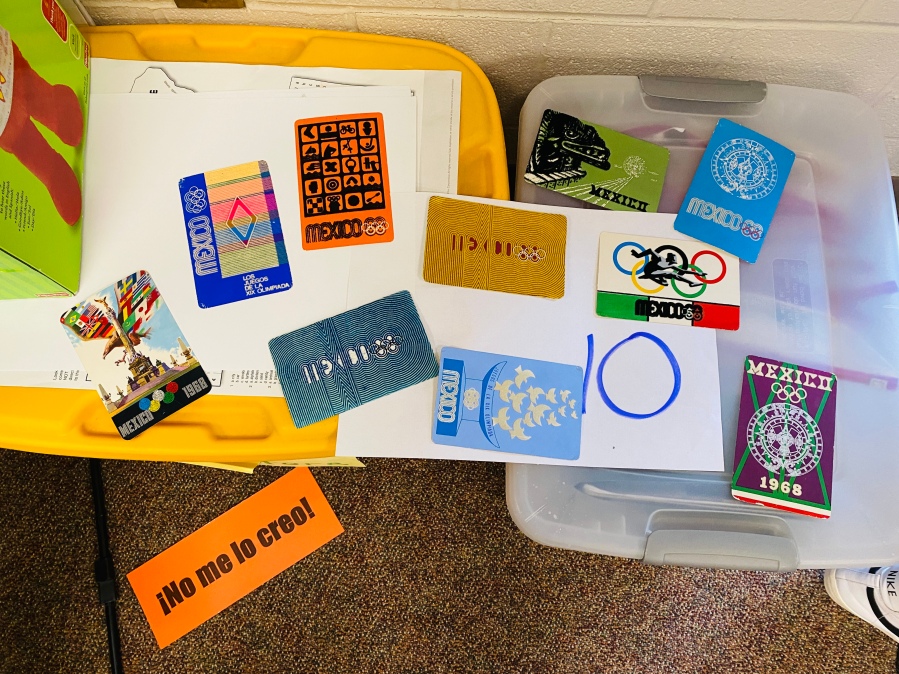In continuing with my reflection on Spanish II during the 2022-23 school year, I set this goal for myself: I will create a variety of interpretive activities and tasks to help students analyze cultural products and realia to build perspective and proficiency using materials I have brought back from travel.
If you have read the blog in the past, I have mentioned I am a collector and this mentality allows me to find value in any object with Spanish writing, for this reason, anything can end up in some cultural realia bag of mine. So this year I wanted to open all of those cultural realia bags (filled with cultural products brought back by me or my former teachers or peers from the 1960s on up). I mean I have postcards from the 1968 Summer Olympics in Mexico, a Kentucky Fried Chicken box from then as well (long before KFC was branded name of choice), menus, tickets, and bags of food with the foods still in tact (I am looking at you 20 year old corn puff snacks from Spain).
So this year, seeing how my Spanish II students really needed to more regularly stand up and move around my rather small classroom, I designed 8 cultural object hunts that could be easily replicated by any teacher just using image searches or some cultural realia that could be sitting on a shelf, in a basement, or even organized in culture bags like mine and again, still not being used. These types of activities can be used with students of all ages and levels.
Overall, my students liked these 7 to 12 minute activities that had them analyzing the cultural products while walking around our room. Here you can find the Cultural templates of the various activities that I designed that can be adapted for any language classroom. For each activity I would put about 10 items around the classroom with a number and provide students with a table to fill in as they worked in small groups to analyze the products. I did often remind students that they should handle all of the cultural products with care and respect.
These activities were especially effective on my 90 minute block days and even though they were usually random cultural activities (yet certainly still hitting many standards), two students’ comments on my end of the year survey left me thinking:
–I didn’t really like when we would walk around and do the culture things, it was interesting but didn’t really teach me that much.
-The cultural walking activities and extra cultural readings were not important because that information was not ever on quizzes.
When I read these, I am sure I had quite a look on my face because I was so happy to have included this new and novel way to push students to interact with cultural products. Remember, I have been bringing back all of these items for so many years from Spanish-speaking places to use (but in reality I was not using them). Do I have to actually add more of a sense of accountability for my students? I mean, they do have to fill in the table on a sheet of paper. After those initial thoughts, I said to myself “Take that look off your face, Gary, and perhaps try this.” In the fall, I will try to add some self-reflection questions in English that have students responding while thinking about how the products are culturally relevant and/or related to daily life, formal Culture, practices, or perspective. In my planning I will check out these these Intercultural Reflection Sheets that the State of Ohio’s Department of Education World Language Team has created as they relate to the Intercultural Competencies set out by NCSSFL-ACTFL Intercultural Reflection Tool and Can-Do Statements.
For Spanish teachers, remember my video resources and questions from the Hispanic Cultural Competency Collection that also complement the Intercultural Competencies.
Again, here are the templates for my 8 Quick Cultural Fill-in Walkabout Activities.
REMEMBER HELP ME REACH THE GOAL OF ADDING 15 NEW SUBSCRIBERS FROM THIS POST:
REMEMBER TO PLAY THE FIND THE MUSICAL THEATRE REFERENCE, DESCRIPTION HERE


Pingback: Summer Series Reflections 2023 – My Mosaic of World Language Teaching